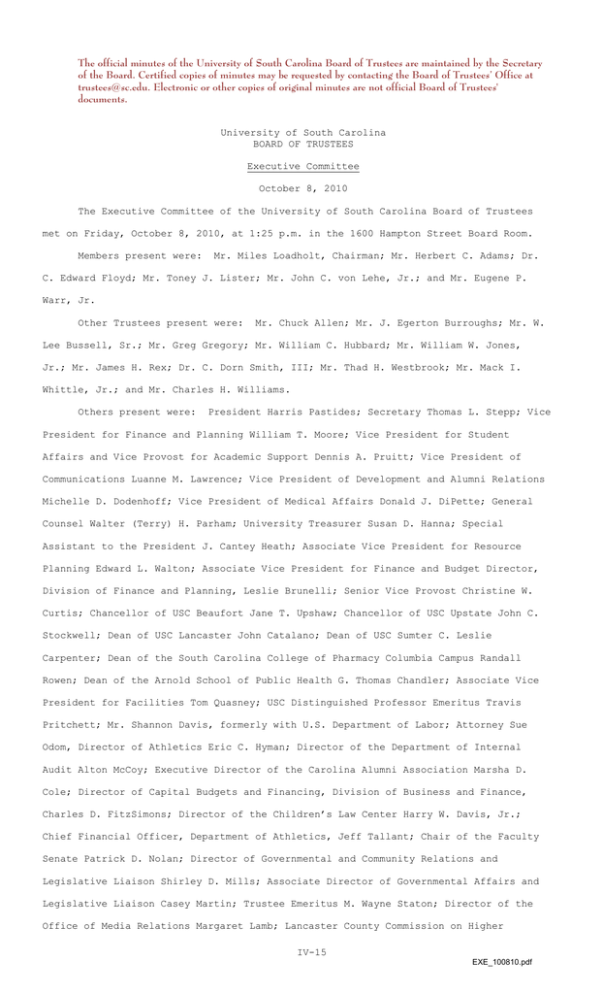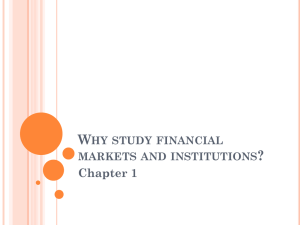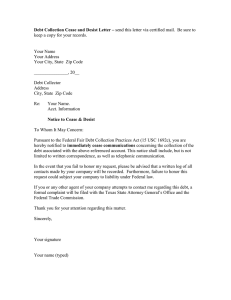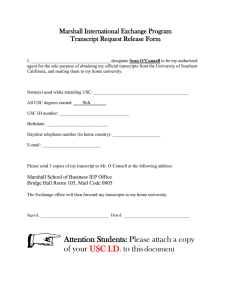Document 14162995
advertisement

The official minutes of the University of South Carolina Board of Trustees are maintained by the Secretary of the Board. Certified copies of minutes may be requested by contacting the Board of Trustees’ Office at trustees@sc.edu. Electronic or other copies of original minutes are not official Board of Trustees' documents. University of South Carolina BOARD OF TRUSTEES Executive Committee October 8, 2010 The Executive Committee of the University of South Carolina Board of Trustees met on Friday, October 8, 2010, at 1:25 p.m. in the 1600 Hampton Street Board Room. Members present were: Mr. Miles Loadholt, Chairman; Mr. Herbert C. Adams; Dr. C. Edward Floyd; Mr. Toney J. Lister; Mr. John C. von Lehe, Jr.; and Mr. Eugene P. Warr, Jr. Other Trustees present were: Mr. Chuck Allen; Mr. J. Egerton Burroughs; Mr. W. Lee Bussell, Sr.; Mr. Greg Gregory; Mr. William C. Hubbard; Mr. William W. Jones, Jr.; Mr. James H. Rex; Dr. C. Dorn Smith, III; Mr. Thad H. Westbrook; Mr. Mack I. Whittle, Jr.; and Mr. Charles H. Williams. Others present were: President Harris Pastides; Secretary Thomas L. Stepp; Vice President for Finance and Planning William T. Moore; Vice President for Student Affairs and Vice Provost for Academic Support Dennis A. Pruitt; Vice President of Communications Luanne M. Lawrence; Vice President of Development and Alumni Relations Michelle D. Dodenhoff; Vice President of Medical Affairs Donald J. DiPette; General Counsel Walter (Terry) H. Parham; University Treasurer Susan D. Hanna; Special Assistant to the President J. Cantey Heath; Associate Vice President for Resource Planning Edward L. Walton; Associate Vice President for Finance and Budget Director, Division of Finance and Planning, Leslie Brunelli; Senior Vice Provost Christine W. Curtis; Chancellor of USC Beaufort Jane T. Upshaw; Chancellor of USC Upstate John C. Stockwell; Dean of USC Lancaster John Catalano; Dean of USC Sumter C. Leslie Carpenter; Dean of the South Carolina College of Pharmacy Columbia Campus Randall Rowen; Dean of the Arnold School of Public Health G. Thomas Chandler; Associate Vice President for Facilities Tom Quasney; USC Distinguished Professor Emeritus Travis Pritchett; Mr. Shannon Davis, formerly with U.S. Department of Labor; Attorney Sue Odom, Director of Athletics Eric C. Hyman; Director of the Department of Internal Audit Alton McCoy; Executive Director of the Carolina Alumni Association Marsha D. Cole; Director of Capital Budgets and Financing, Division of Business and Finance, Charles D. FitzSimons; Director of the Children’s Law Center Harry W. Davis, Jr.; Chief Financial Officer, Department of Athletics, Jeff Tallant; Chair of the Faculty Senate Patrick D. Nolan; Director of Governmental and Community Relations and Legislative Liaison Shirley D. Mills; Associate Director of Governmental Affairs and Legislative Liaison Casey Martin; Trustee Emeritus M. Wayne Staton; Director of the Office of Media Relations Margaret Lamb; Lancaster County Commission on Higher IV-15 EXE_100810.pdf Education Representative Charles A. Bundy; University Technology Services Production Manager Justin Johnson; Board staff members Terri Saxon, Vera Stone, and Karen Tweedy; and members of the media. Chairman Loadholt called the meeting to order and invited those present to introduce themselves. Ms. Lamb introduced members of the press who were present. Chairman Loadholt stated that notice of the meeting had been posted and the press notified as required by the Freedom of Information Act; the agenda and supporting materials had been circulated; and a quorum was present to conduct business. Chairman Loadholt stated that there were personnel and contractual matters and receipt of Legal advice which were appropriate for discussion in Executive Session. Mr. Adams moved to enter Executive Session. Mr. Warr seconded the motion. The vote was taken, and the motion carried. Chairman Loadholt invited the following persons to remain: President Pastides, Secretary Stepp, Dr. Moore, Ms. Owens, Dr. Pruitt, Dr. Hogue, Dr. Kresovich, Dr. Plyler, Dr. Curtis, Ms. Lawrence, Ms. Dodenhoff, Mr. Parham, Mr. Heath, Mr. Walton, Ms. Brunelli, Ms. Gowan, Mr. McCoy, Mr. Hyman, Ms. Gidon, Ms. Sue Odom, Dr. Travis Pritchett, Mr. Shannon Davis, Mr. Gregory, Mrs. Martin, Ms. Mills, and Mrs. Lamb. IV-16 EXE_100810.pdf Return to Open Session I. Contracts Valued in Excess of $250,000: A. Basketball Charter Flight – Delta Airlines: Chairman Loadholt called on Mr. Parham who on behalf of Athletics, sought board approval to enter into a charter flight agreement with Delta Air Lines under which the men’s basketball team would be transported to their ten away games this season: Michigan State; Western Kentucky; Ohio State; Alabama; Florida; LSU; Vanderbilt; Tennessee; Kentucky; and Mississippi State. This was the standard charter flight agreement that Athletics had entered into for the past few years. The total cost of the contract was $274,684.00. Prior to selecting Delta Air Lines, the Athletics Department obtained quotes from a total of three airlines offering charter services. availability. Delta was selected because of The Athletics Department had used Delta on several occasions in the past and was well satisfied with the service; and Delta had the lowest bid of $274,684. The other bids were $382,047 and $502,374. By way of comparison, the cost of eight charter flights for the men’s basketball team last year cost $264,845.85. Mr. Adams moved to approve the contract as distributed in the meeting materials. Mr. Warr seconded the motion. B. The vote was taken, and the motion carried. Coin Laundry Contract - Mac-Gray Campus Solutions: Mr. Parham reported on behalf of University Housing who was seeking Board approval to enter into an agreement with Mac-Gray Campus Solutions to provide coin-operated laundry machines and services to University residence halls on the Columbia campus. The current five-year contract expired June 30, 2010. A competitive bid was conducted, in accordance with the South Carolina Consolidated Procurement Code. In May, the University issued a Request for Proposals for Coin- Operated Laundry services. responsive. Three companies responded, one of which was found to be non- Of the remaining two companies, Mac-Gray was ranked the highest and deemed to be most advantageous to the University. The proposed contract was for a five-year term. Under the contract, Mac-Gray would be responsible for providing new, commercial grade washers and dryers in University residence halls across campus. to $450,000 by Mac-Gray. This represented an investment of $400,000 These washers and dryers would be equipped with coin slots, audit systems and non-re-settable counters so that an accurate record of use could be maintained, and would be connected to the University’s Carolina Card system so that students could conveniently swipe their card rather than use cash. Mac-Gray was also responsible for securing and cleaning the equipment, repairing the equipment within 24 hours of notification, and maintaining liability insurance ($500,000 per occurrence; $1 million aggregate.) Under the contract, Mac-Gray guaranteed the University $180,000 annually or a IV-17 EXE_100810.pdf 60.5 percent commission on gross sales, whichever was greater. (This compares to $168,000 or a 56 percent commission under the existing contract.) In addition to the revenue, Mac-Gray would provide $45,000 in renovations to the laundry rooms. Mr. von Lehe moved to approve the contract as described in the meeting materials. Mr. Lister seconded the motion. C. The vote was taken, and the motion carried. Pacific Biosciences: On behalf of the Office of Research, Mr. Parham sought board approval to purchase from Pacific Biosciences, a state-of-the-art DNA sequencing platform, consisting of equipment and software. This technology would be used by Dr. Steve Kresovich, Vice President for Research, who also held an Endowed Chair in Genomics as a Professor of Biological Sciences at USC. The purchase price for the sequencing platform was $767,000. The value of the equipment and software was that it allowed DNA sequencing of single molecules of DNA in real time, a process that traditionally would take weeks. This resulted in reduced costs and the potential to serve more scientists. Also, the output from the system provided very long reads of DNA sequence, thereby making the bioinformatics requirements for subsequent analysis to be both cheaper and more simple. The source of funding was being paid in part by the College of Arts and Sciences and by the Office of Research, from funds set aside when Dr. Kresovich was hired. Dr. Floyd moved for approval of the agreement as submitted in the meeting materials. II. Mr. Adams seconded the motion. The vote was taken, and the motion carried. Off-Cycle Fee Request - USC Upstate Activity Fee: Chairman Loadholt called on Dr. Moore, who said that USC Upstate was proposing an off-cycle fee to be implemented January 1, 2011; for athletic insurance for student-athletes as required by the NCAA. Given budget constraints, the campus was unable to provide this coverage to all studentathletes. The campus requested approval to proceed with a Request for Proposal (RFP) for a third party provider of this insurance. The actual fee was expected to range from $780 to $1000 per year for the student athletes. If a student had independent coverage that satisfied this requirement, the USC Upstate campus could waive the fee. The fee was to certify that all student-athletes had coverage and would be facilitated by placing the charge on the student bill each term. Previous practice had led to individual team coaches collecting insurance fees and remitting them to the third party providers. Sound business practices and audit requirements necessitated that a formal procedure be implemented. This coverage requirement did not apply to USC Aiken or USC Beaufort as those institutions were not Division I. Mr. Warr moved to approve the USC Upstate Athletic Activity Fee (Off-Cycle Fee) as distributed in the meeting materials. Mr. Lister seconded the motion. A vote was taken, and the motion carried. III. Prudential Demutualization: Chairman Loadholt called on Dr. Moore who IV-18 EXE_100810.pdf reported that a team had been at work since February in determining how to dispose of proceeds from demutualization of Prudential Corporation which took place in 2000. Approximately $4.8 million had been distributed to the University in the form of dividends and stocks. proceeds: The team considered three possible applications of those 1) the University could retain the proceeds for general University purposes; 2) the University could use the proceeds for the perspective benefit of Prudential clients who were employees of the University; 3) the University could distribute the proceeds to plan contributors including those who were now employed, those who had retired from the University, and those who had left the University for other reasons. The team unanimously recommended distribution of the proceeds to the approximately 1,800 plan contributors. Under the proposal, the funds would be distributed to employees or former employees who, as of December 15, 2000, were actively employed by the University and insured by Prudential; retired from the University with death benefits from Prudential; disabled with death benefits from Prudential; and those who had paid up cash value policies. Dr. Moore reported that the team recommended the proceeds of the demutualization, net of $200,000 of administrative expenses, be disbursed to the four classes as described. Mr. Adams moved to accept the Prudential Demutualization Team’s recommendation. Mr. Warr seconded the motion. IV. The vote was taken, and the motion carried. USC Bond Indebtedness Report: Dr. Moore stated that the Board had been provided with a Comprehensive Debt Report; which would be presented to the Executive Committee quarterly or more frequently if needed. It served a threefold purpose: to keep the board informed about strategic debt management; to alert the board to various market conditions and opportunities for strategic financing decisions; and to report on compliance with debt agreements with covenants which were contained in the various bonds. During the last fiscal year, and so far this year, the University had issued $125 million of debt. Approximately $17.6 million of that debt was to retire Athletic Bond Anticipation Notes, thereby converting short term debt into long term debt. The most recent issuance included a component to refund just over $11 million of outstanding bonds at a reduced interest rate, resulting in present value savings of almost $1 million. Further, Dr. Moore stated that University Bond Indebtedness totaled approximately $450,340,000 as of September 2010. This figure included State Institution Bonds, Revenue Bonds, Athletics Facilities Revenue Bonds, and School of Medicine Education Trust Revenue Bonds and Notes. He showed a breakdown of bond indebtedness by campus and category. Dr. Moore gave a summary of University debts and assets. IV-19 The University was in EXE_100810.pdf very good shape and within the required ratios. The grand total of all University related debt for the current fiscal year was $586,204,824. The projected debt for FY 2012 was $680,474,219 and $668,413,772 for FY 2013 assuming certain projects went forward. The current total assets were $2.1 billion dollars and he projected a five percent growth rate in assets per year through 2013. He summarized debt covenants and restrictions. With the exception of the two cases of technical defaults mentioned previously (one of which to be resolved today), the University was in compliance with all other debt issues. The University had identified $170.5 million of projects that would require financing. Each of these projects had been considered by the Capital Planning Committee, and many of them were being, or had been considered, by the Board. Dr. Moore stated that the Board would review all of these items as they move through the approval process for both the projects as well as their respective bond funding. The University’s bond rating was Aa2. Moody’s rates 220 public colleges and universities as well as private institutions. Based on FY 2009 information from Moodys, the ratings and number of public institutions were as follows: Aaa (8); Aa1 (15); Aa2 (44) (including USC); Aa3 (40); A1 (65); A2 (31); A3 (14); Baa1 (2); and Baa3 (1). The Aaa Institutions included Michigan, Indiana, Purdue, UNC, Virginia, Texas, Texas A&M, and University of Washington. were as follows: South Carolina Colleges and Universities Bond Ratings Aa2 (USC and Clemson); Aa3 (Citadel); A1 (MUSC, College of Charleston, Coastal Carolina University, and Furman University); and B3 (Benedict College. Chairman Loadholt stated that this report was received for information. V. Bond Refunding Resolution: A. Refund Series 2001B State Institution Bonds: Dr. Moore proposed a Resolution to issue State Institution Refunding bonds for $22.2 million to be used to refund outstanding Series 2001 B State Institution Bonds. By doing so, he projected a substantial debt service savings of approximately $2.7 million in present value terms. USC had a bond refunding opportunity involving a state institution bond series that was issued in 2001 in the amount of $20.8 million. He anticipated this bond would have an Aaa rating because the state had an Aaa rating. Dr. Moore sought Board approval to refund outstanding bonds in order to take advantage of favorable interest rates and reduce overall cost for the original borrowing. The amount of the Resolution was higher than the amount of outstanding bonds to allow for issuance costs. The amount of Bonds issued would only be the amount needed when the final structure of the issuance was determined. Dr. Floyd moved to approve the Bond Refunding Resolution as stated in the meeting materials. Mr. Lister seconded the motion. B. The vote was taken, and the motion carried. The School of Medicine Educational Trust: IV-20 Dr. Moore proposed a EXE_100810.pdf resolution for the School of Medicine Educational Trust issued in September 2000. The Trust issued debt was $10.6 million to purchase Medical Park II and Medical Park IV. The current outstanding balance was $6.8 million. That debt included a covenant that required the University to maintain a debt-net assets/equity ratio no greater than one. USC had violated that covenant in the past and had been provided a waiver. Arrangements were made to replace that debt covenant with one that specified the long-term debt only as opposed to total debt, which would include current divided by total assets. In addition, the covenant limit was increased from 1 to 1.2. If this covenant had been in place for the last several years, the bond would not have been in a technical default. All the other parameters of the bond remained the same. After conversing with the debt holder, Wachovia, the University determined that the best approach was to modify the agreement to more appropriately consider the School’s assets. Dr. Moore proposed a new Debt Agreement to modify the previous covenant, such that the University was no longer in violation. The administration had implemented changes at the School of Medicine to ensure that the University would continue compliance with the new Debt Agreement. He requested that the administration be allowed to enter into the modified debt agreement. Dr. Floyd moved to approve the modified School of Medicine Educational Trust Debt Agreement. VII. Mr. von Lehe seconded the motion. The vote was taken, and the motion carried. Contracts Valued in Excess of $250,000: A. Athletics Contracts: Head Baseball Coach Ray Tanner Employment Agreement Amendments: Mr. Parham requested board approval to amend Coach Tanner’s employment agreement in terms of base salary, supplemental compensation, guaranteed media compensation, tax deferred compensation plan, incentive compensation and termination provision. The current term of the contract would expire on June 30, 2013 and a request was made for a two year extension of the agreement, therefore, the contract would expire on June 30, 2015. The base salary would increase from $190,195 to $210,000; and supplemental compensation would increase from $85,000 to $100,000. Coach Tanner’s current media compensation, from the Athletics Department’s broadcast rights holder, would increase from $125,000 to $200,000. His incentive based supplemental compensation would increase by $110,000, from $145,000 to $255,000, contingent upon the performance of the baseball team Academic Progress Rate (APR), and if USC was a host site for the NCAA Regionals or Super Regionals at the conclusion of a regular season. Coach Tanner’s salary was ranked fourth in the SEC behind LSU, Mississippi State, and Mississippi in terms of guaranteed compensation paid to baseball coaches. There were no proposed changes in the University’s contribution amounts to Coach Tanner’s Tax Deferred Compensation Plan. However, each contribution would vest on the date on the made if Coach Tanner was employed by the Athletics Department on that date. IV-21 EXE_100810.pdf Currently, if Coach Tanner terminated the contract and accepted any baseball coaching position at the collegiate level at any time during the then remaining term of the contract, he was obligated to pay the University his base salary for the remaining term of his contract. He would also waive all rights to the tax deferred compensation plan to the extent he had not vested in the Plan as of the effective date of termination. Under the proposal, if he terminated the contract, he would waive all rights to the benefits of the tax deferred compensation plan to the extent he had not vested in the Plan as of the effective date of termination. In closing, Mr. Parham stated that Coach Tanner was currently the senior baseball coach in the SEC and had just completed his 14th year at USC. Also, he was the baseball national Coach of the Year. Mr. Adams moved to approve the amendments to the employment agreement of Coach Tanner’s as described in the meeting materials. Mr. Warr seconded the motion. The vote was taken, and the motion carried. B. Head Basketball Coach Darrin M. Horn Amendment #2 to Employment Agreement: Mr. Parham reported that there was one proposed amendment to Head Basketball Coach Darrin M. Horn employment agreement related to a buyout. Paragraph 13.03(b) Termination by Employee clause of the agreement would read: (b) Employee’s Obligation Upon Termination. In the event this Employment Agreement is terminated by the employee. The Employee shall pay the University its exclusive remedy in lieu of any and all other legal remedies or equitable relief available to the University, and without regard to actions by the University to mitigate its damages, liquidated damages were as follows: (1) Eight Hundred Thousand Dollars ($800,000.00) if Employee terminates this Employment Agreement at any time during the Contract Year beginning April 1, 2010 and ending March 31, 2011; (2) Six Hundred Thousand Dollars ($600,000.00) if Employee terminates this Employment Agreement at any time during the Contract Year beginning April 1, 2011 and ending March 31, 2012; (3) Five Hundred Thousand Dollars ($500,000.00) if Employee terminates this Employment Agreement at any time during the Contract Year beginning April 1, 2012 and ending March 31, 2013; (4) Five Hundred Thousand Dollars ($500,000.00) if Employee terminates this Employment Agreement at any time during the Contract Year beginning April 1, 2013 and ending March 31, 2014; (5) Five Hundred Thousand Dollars ($500,000.00) if Employee terminates this Employment Agreement at any time during the Contract Year beginning April 1, 2014 and ending March 31, 2015. or any subsequent Contract Year in the event that the term of this Employment Agreement is extended by mutual agreement of the parties. (6) Employee shall pay such liquidated damages either in lump sum within ninety (90) days of the effective date of termination, or in equal monthly installments over the remaining term of this Employment Agreement until paid in full, or as otherwise mutually agreed upon by the parties. Mr. Lister moved to approve the agreement as described in the meeting materials. Mr. von Lehe seconded the motion. VIII. The vote was taken, and the motion carried. Board of Visitors Appointment: Chairman Loadholt called on Mr. Stepp who IV-22 EXE_100810.pdf stated that during the Executive Session, the Committee considered Trustee Mark Buyck’s recommendation of William Weston from Augusta, Georgia to be nominated by this committee to the full Board, as an out-of-state member of the Board of Visitors. There were no objections, and the board unanimously consented to the appointment of William Weston II as the out-of-state member to the Board of Visitors. IX. Other Matters: Contract Approval Policy: Mr. Warr stated that the Board had several discussions regarding the contract approval policy. He stated that Mr. Burroughs and Mr. Jones had recommended that this matter be handed over to the full Board for consideration. However, since it was an Executive Committee matter, at this point, he suggested that Executive Committee to give that approval. Mr. von Lehe moved that the full Board consider this matter in the future. Adams seconded the motion. Mr. The vote was taken, and the motion carried. Since there were no other matters to come before the Executive Committee, Chairman Loadholt declared the meeting adjourned at 3:00 p.m. Respectfully submitted, Thomas L. Stepp Secretary IV-23 EXE_100810.pdf



